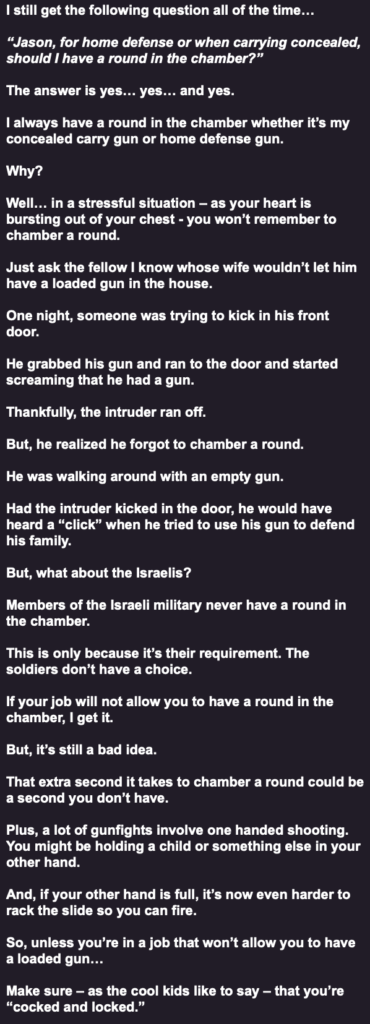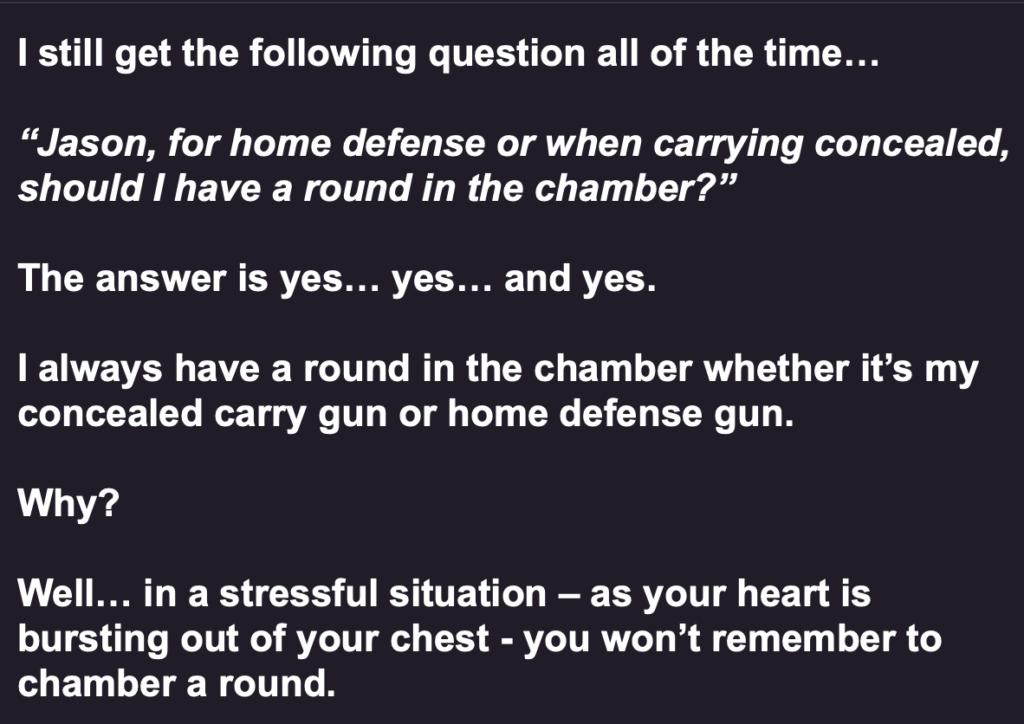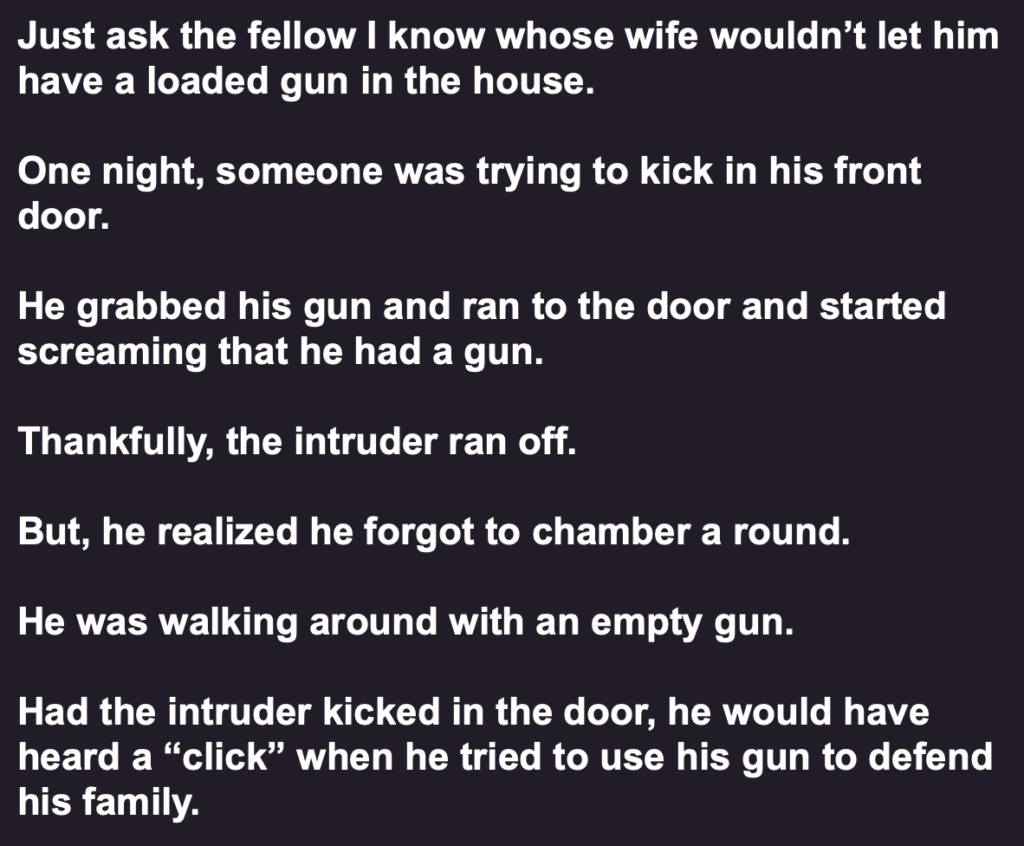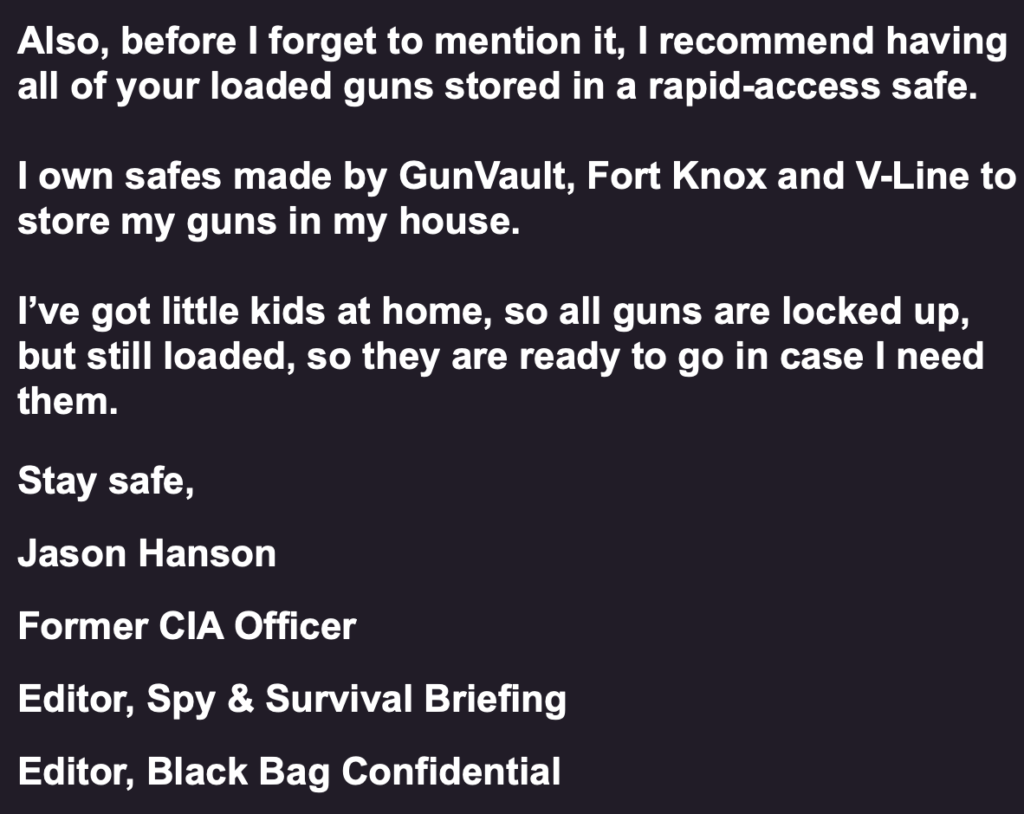If you’ve read past posts, you’d know I’m a gun guy. I’m interested in all topics guns — history, how they work, carrying, all that stuff.
So I’m on a few lists that discuss that stuff. But it’s usually in the context of self-defense or prepping.
One list I’m subscribed to is run by a former CIA agent, Jason Hanson, who runs businesses in these niches.
They sell prepping and self-defense info products, and I think physical products like knives and pistol safes.
A lot of Mr. Hanson’s emails either tell stories or shift beliefs (and often uses a story to shift a belief).
Today, we’re going to break down an email he wrote about a BIG pain point among people new to carrying a firearm concealed.
Let’s get into it.
The Email: A “Belief-Shifter”
This one’s fairly long and all text, but it doesn’t need any images if it connects with the reader and pulls them eagerly down the page.



Before I cover the subject line, notice the line spacing and varied sentence lengths.
Keeps things readable. Combined with a good story, it makes the email irresistible.
Now, the subject line.
The Subject Line: What Are the Israelis Wrong About?

That seems random. What are the Israelis dead wrong about?
People that don’t know might click simply for the randomness. However, some will know this is in reference to carrying with an empty chamber — known by some as “Israeli carry” because the Israeli Defense Force (IDF) famously carry with an empty chamber.
(I’m ignorant of the term’s history or whether the IDF are the only ones who do it, or if it’s even true. But it stuck so let’s operate under the assumption that this is true.)
Many new concealed carriers do “Israeli carry” for a while. After all, when you carry, the muzzle’s usually angled slightly towards you body. Having a loaded firearm pointed at you all day isn’t the most comforting thought, even if modern, well-maintained handguns will essentially never go off unless the trigger is pulled.
With that context, you can see how this creates some polarization. Jason’s declaring this military force is dead wrong about a tactical decision… and one that’s relevant to a big fear (shooting yourself by accident) among his target audience.
Plus, curiosity. How will Jason prove the Israelis and other empty-chamber carriers wrong?
You gotta open the email to see.
The Intro: A “Common Question”

I like how he starts out with a “common question” he gets all the time, then states the question in quotes. I can tell you this is a common question, so it keeps the reader hooked.
He then answers flat-out, along with his reasoning.
Notice how he gives a logical answer… but infuses emotion.
He doesn’t just say, “You need a round ready to defend yourself.” *Snooze*
He gets a bit descriptive with “as your heart is bursting out of your chest.”
The truth is, people don’t buy (or make many types of decisions) purely on logic. In many cases, they buy/make decisions on emotion — and justify their choice with logic to feel good about themselves.
And trust me, he ratchets up the emotion as we proceed more.
Story Time

This is what I’m talkin’ about. Story time. In this niche, stories about life or death are common, yet they can hit hard.
He also adds specificity with the “a fellow I know” line instead of just saying “one guy” or something like that.
Notice the story’s only a few lines. Yet you can kinda picture him snagging the firearm and sprinting to the door… and the concerning “click” of an empty gun when faced with a violent intruder who would be more than happy to get his hands on that gun.
The story demonstrates Mr. Hanson’s point about the one-in-the-chamber debate better than just telling you because it injects emotion and dimensionalizes the benefit of what he’s suggesting. You can picture exactly what would happen if the man in the story didn’t have round in the chamber ready to go if the intruder got it.
It other words, it uses story and emotion to show you, not tell you… helping to shift your belief to Mr. Hanson’s point of view.
Back to The Israelis

Now, your belief is partially shifted. You’ve seen an example of how horribly wrong an unloaded chamber can go in a home defense scenario.
But you’re still wondering — why does a professional military force (the Israelis) not do this? Their job is to wield weapons effectively in service to their country. If it’s bad for homeowners, why do military personnel do it?
You still have an objection. But Mr. Hanson diffuses that. At the same time, he shows conviction in his position by taking a stand and claiming the Israelis are still wrong, even if they have to do it per their job requirements. And he shows you more logical reasons (mixed with emotion) why his view is right and why you should adopt his belief.
Conviction like that is attractive to customers. It shows you know what you’re talking about, and you’re willing to back up your view. It brings in people that think like you, and those are some of the most loyal customers because they want to be associated with like-minded people/brands.
Once More, With Feeling

A short section here, but he reiterates that, at all costs, you should keep one in the chamber.
With a bit of humor and personality sprinkled in there.
Call To Action

Mr. Hanson proved his point, increased his authority on all things firearm self-defense related in the recipient’s eyes, and built more trust with the reader by answering a burning question.
At that point, the CTA comes fairly naturally. He doesn’t have to try too hard, especially since he’s pushing a free product. He simply has to stay on the topic of firearm self-defense tips, and he uses the CTA to offer the reader more tips on the subject with their free eBook.
He doesn’t use a “click here” CTA either. Again, he doesn’t have to. I like how he hyperlinks the text within the sentence.
More Tips, Signoff… and What? No Affiliate Links?

Keeping emails casual is best. You should make it sound like you’re writing to a friend.
Mr. Hanson does that well by breaking slightly from a standard email structure. The CTA isn’t at the very end. Instead, he adds a couple tips about firearm storage with some product recommendations. He connects with the reader by talking about his kids — and I guarantee the majority of his audience also has kids (that they, of course, want to keep their firearms away from.)
The interesting part is he doesn’t have affiliate links for the gun safes he recommends.
Maybe he just hasn’t got around to being an affiliate, but I’m more optimistic.
Given the subject matter, this shows he really cares about his customers. They’re not just bags of money. They’re real people, and he wants them to own, store, and handle firearms safely and effectively.
Takeaways
Primary among your copy’s goals (aside from selling your product/service) is to shift beliefs (without lying, of course.)
You have to get your customer to see your point of view. You need them to believe the right things (ethically and honestly) to buy from you.
This email is a great example. Mr. Hanson addresses a hot topic for new firearms owner, takes a stand on the issue, and uses a mix of logic, emotion, and story to bring you to his view.
This might push some customers away who disagree with him… but that’s fine because he pulls in other customers who get his point.
Plus, the email builds his authority in the reader’s eyes and makes him look like he cares about his customers first.
That, my friend, will earn you more money than chasing money itself.
What to Do Next
- Get on my email list.
- Reach out to me if you want help writing belief-shifting emails like this one.
- Check out Mr. Hanson’s Spy Briefing website if you’re interested.
